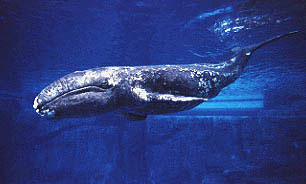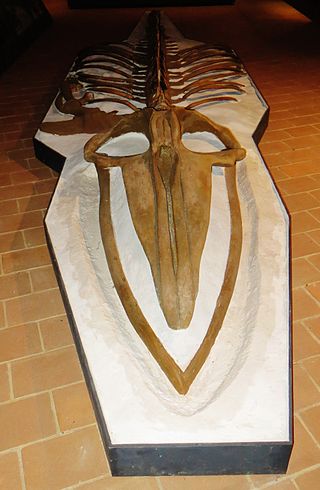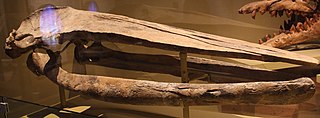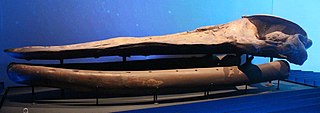
Eschrichtiidae or the gray whales is a family of baleen whale with a single extant species, the gray whale, as well as three described fossil genera: Archaeschrichtius and Eschrichtioides from the Miocene and Pliocene of Italy respectively, and Gricetoides from the Pliocene of North Carolina. More recent phylogenetic studies have found this family to be invalid, with its members nesting inside the Balaenopteridae. The names of the extant genus and the family honours Danish zoologist Daniel Eschricht.

Neobalaenidae is a family of baleen whales including the extant pygmy right whale. Although traditionally considered related to balaenids, recent studies by Fordyce and Marx (2013) and Ludovic Dutoit and colleagues (2023) have recovered the living pygmy right whale as a member of Cetotheriidae, making it the only extant cetotheriid. Not all authors agree with this placement.

The pygmy right whale is a species of baleen whale. It may be a member of the cetotheres, a family of baleen whales which until 2012 were thought to be extinct; C. marginata has otherwise been considered the sole member of the family Neobalaenidae and is the only member of the genus Caperea. First described by John Edward Gray in 1846, it is the smallest of the baleen whales, ranging between 6 and 6.5 metres in length and 3,000 and 3,500 kilograms in mass. Despite its name, the pygmy right whale may have more in common with the gray whale and rorquals than the bowhead and right whales.

Cetotherium is an extinct genus of baleen whales from the family Cetotheriidae.
Parabalaenoptera is a genus of prehistoric baleen whale found in Marin County, California. The type species is P. baulinensis. It was estimated to be about the size of the modern gray whale, about 16 metres (52 ft) long. It lived during the late Miocene.

Cetotheriidae is a family of baleen whales. The family is known to have existed from the Late Oligocene to the Early Pleistocene before going extinct. Although some phylogenetic studies conducted by Fordyce & Marx 2013 recovered the living pygmy right whale as a member of Cetotheriidae, making the pygmy right whale the only living cetotheriid, other authors either dispute this placement or recover Neobalaenidae as a sister group to Cetotheriidae.

Parietobalaena is an extinct genus of baleen whale, belonging to the family Pelocetidae. Fossils are found in Miocene-aged marine strata in North America, Europe, Australia, and Japan, including the Temblor and Itahashi formations. Based on previous estimates of juvenile specimens, Tsai (2017) suggested a body size of 12-15 m for P. yamaokai, akin to that of the gray whale.

Protororqualus is a genus of extinct rorqual from the late Pliocene of Mount Pulgnasco, Italy.
Plesiocetus is a genus of extinct rorquals found worldwide. It has had a chequered taxonomic history, having served as a wastebasket genus for a handful of mysticete species.

Eschrichtioides is an extinct genus of baleen whale known from the early Pliocene of Northern Italy. Its type species, E. gastaldii, had a complex taxonomic history, starting as a cetothere, then as an extinct member of Balaenoptera, before being finally recognized as a relative of the gray whale.
Miocaperea is an extinct genus of pygmy right whale from the Late Miocene Pisco Formation of Peru. Its type species is Miocaperea pulchra.

Cetotheriopsis is a genus of extinct cetaceans of the family Cetotheriopsidae.

Aglaocetus is a genus of extinct baleen whales known from the Miocene of Patagonia, the US Eastern Seaboard, Japan and the Low Countries. It was once considered a member of Cetotheriidae along with many other putative cetotheres, but was recently recognized as representing a distinct family from true Cetotheriidae.

Mixocetus is a genus of extinct baleen whale belonging to the family Tranatocetidae. It is known only from the late Miocene (Tortonian) of Los Angeles County, California.
Nannocetus is an extinct baleen whale belonging to the family Cetotheriidae.
Tohoraata is a genus of eomysticetid baleen whale from the Late Oligocene (Chattian) of New Zealand. There are two recognized species, T. raekohao and T. waitakiensis.
Eucetotherium is a genus of cetotheriid mysticete from Miocene (Tortonian) marine deposits in the Russian Caucasus.
Isocetus is an extinct genus of baleen whale belonging to the clade Thalassotherii. Remains have been found in middle Miocene marine deposits in Belgium.
Otradnocetus is an extinct genus of baleen whale from the middle Miocene of the Russian Caucasus.










